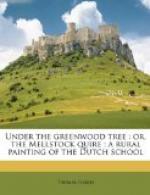“Not nice of Master Enoch,” said Dick, as they resumed their walk.
“You mustn’t blame en,” said Geoffrey; “the man’s not hisself now; he’s in his morning frame of mind. When he’s had a gallon o’ cider or ale, or a pint or two of mead, the man’s well enough, and his manners be as good as anybody’s in the kingdom.”
CHAPTER II: UNDER THE GREENWOOD TREE
The point in Yalbury Wood which abutted on the end of Geoffrey Day’s premises was closed with an ancient tree, horizontally of enormous extent, though having no great pretensions to height. Many hundreds of birds had been born amidst the boughs of this single tree; tribes of rabbits and hares had nibbled at its bark from year to year; quaint tufts of fungi had sprung from the cavities of its forks; and countless families of moles and earthworms had crept about its roots. Beneath and beyond its shade spread a carefully-tended grass-plot, its purpose being to supply a healthy exercise-ground for young chickens and pheasants; the hens, their mothers, being enclosed in coops placed upon the same green flooring.
All these encumbrances were now removed, and as the afternoon advanced, the guests gathered on the spot, where music, dancing, and the singing of songs went forward with great spirit throughout the evening. The propriety of every one was intense by reason of the influence of Fancy, who, as an additional precaution in this direction, had strictly charged her father and the tranter to carefully avoid saying ‘thee’ and ‘thou’ in their conversation, on the plea that those ancient words sounded so very humiliating to persons of newer taste; also that they were never to be seen drawing the back of the hand across the mouth after drinking—a local English custom of extraordinary antiquity, but stated by Fancy to be decidedly dying out among the better classes of society.
In addition to the local musicians present, a man who had a thorough knowledge of the tambourine was invited from the village of Tantrum Clangley,—a place long celebrated for the skill of its inhabitants as performers on instruments of percussion. These important members of the assembly were relegated to a height of two or three feet from the ground, upon a temporary erection of planks supported by barrels. Whilst the dancing progressed the older persons sat in a group under the trunk of the tree,—the space being allotted to them somewhat grudgingly by the young ones, who were greedy of pirouetting room,—and fortified by a table against the heels of the dancers. Here the gaffers and gammers, whose dancing days were over, told stories of great impressiveness, and at intervals surveyed the advancing and retiring couples from the same retreat, as people on shore might be supposed to survey a naval engagement in the bay beyond; returning again to their tales when the pause was over. Those of the whirling throng, who, during




